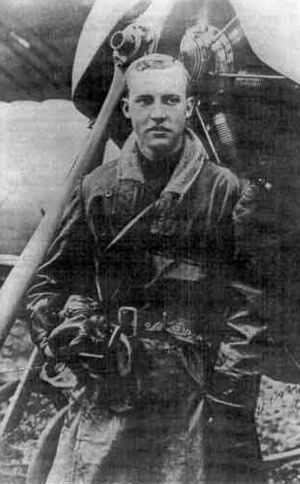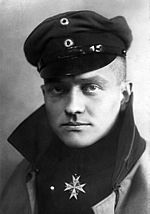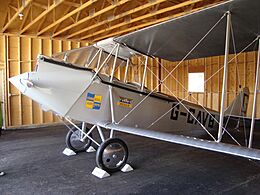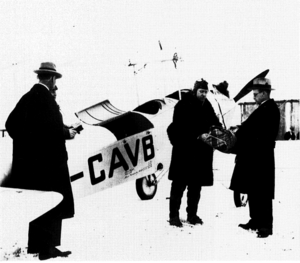Wop May facts for kids
Quick facts for kids
Wilfrid Reid May
|
|
|---|---|

Wop May, c. 1920
|
|
| Born | March 20, 1896 Carberry, Manitoba, Canada |
| Died | June 21, 1952 (aged 56) American Fork, Utah, United States |
| Buried | |
| Allegiance | Canada United Kingdom |
| Service/ |
Canadian Army British Army Royal Air Force |
| Years of service | 1916–1918 |
| Rank | Captain |
| Unit | No. 209 Squadron RAF |
| Battles/wars | First World War |
| Awards | Officer of the Order of the British Empire Distinguished Flying Cross Medal of Freedom (United States) |
Wilfrid Reid "Wop" May (March 20, 1896 – June 21, 1952) was a brave Canadian flying ace during the First World War. After the war, he became a famous aviator who helped open up Canada's North. He is well-known for being the last Allied pilot chased by the famous German pilot, Manfred von Richthofen, also known as the "Red Baron," just before the Baron was shot down in 1918. After the war, May became a bush pilot, flying for Canadian Airways in Northern Alberta and the Northwest Territories.
Contents
Growing Up: How Wop Got His Name
Wilfrid May was born in Carberry, Manitoba, in 1896. His father was a carriage maker. In 1902, his family moved to Edmonton. On their journey, they visited family and friends. His two-year-old cousin, Mary Lumsden, couldn't say "Wilfrid" properly. Instead, she called him "Woppie," which soon became his famous nickname, "Wop." He went to Edmonton High School, which is now called Victoria School of Performing and Visual Arts.
Flying High: Wop May in World War I
Wop May joined the Canadian Army in February 1916, during the First World War. He quickly moved up the ranks to sergeant. For most of 1916, he worked as a gunnery instructor in Canada. In 1917, his army group, the 202nd battalion C.E.F., went to England. There, he and his friend Ray Ross decided to join the Royal Flying Corps, which was the air force at the time.
His very first flight was a bit of a disaster, as he accidentally damaged his own plane and another! But even so, the Royal Flying Corps accepted him. May then left the Canadian Army. After training in London in October, he moved to a fighter training squadron and finished his training in February 1918.
On April 9, 1918, Lieutenant May joined No. 209 Squadron of the new Royal Air Force. This squadron was led by another Canadian, Roy Brown, who was May's old school friend. Brown was known for never losing a pilot under his command. May spent a few days getting used to his Sopwith Camel plane before being sent to France.
May had his first air battle on April 20, 1918. The German Fokker Triplane he was fighting crashed on its own during their short fight.
The Chase: The Red Baron's Last Flight

The very next day, April 21, 209 Squadron was on patrol again. Because Wop May was new to flying in combat, Roy Brown told him to stay out of the main fights. He was just supposed to watch. Around 10 a.m., the squadron attacked a group of German Triplanes. At first, May circled above the dogfight. But when he saw another German plane doing the same thing, he decided to attack.
May chased a German aircraft that flew into the middle of the fight and fired at it. The German pilot he was chasing was Wolfram von Richthofen, who was the cousin of Manfred von Richthofen, the famous "Red Baron." Wolfram was also a new pilot and had been told to stay above the fight and watch.
When Manfred, the Red Baron, saw his cousin being attacked, he flew his bright red Fokker Dr.I to the rescue. He fired at May, making May pull away and saving Wolfram's life. The Red Baron then chased May across the Somme region.
Years later, May talked about this chase. He said, "the first thing I knew I was being fired on from the rear... [and] all I could do was try to dodge my attacker." He noticed it was a red tri-plane. He added, "if I realized it was Richthofen, I would have probably passed out on the spot." May kept dodging and spinning his plane from high in the sky until he was flying very low to the ground. Richthofen kept firing at him. May believed his "poor flying" actually saved him because he didn't know what he was doing, and Richthofen couldn't guess his next move.
Roy Brown, who was flying above, saw the Red Baron chasing May. He dove down very fast to help. He then had to climb steeply to avoid hitting the ground. Richthofen turned to avoid Brown's attack, then went back to chasing May. However, who actually shot down the Red Baron is still a topic of much debate.
Wop May continued flying with 209 Squadron until the war ended. He was credited with shooting down 15 enemy aircraft and possibly five more. He received the Distinguished Flying Cross in 1918. He left the Royal Air Force on May 8, 1919, with the rank of captain.
After the War: A Pioneer of Canadian Aviation

After the war, May returned to Edmonton. He and his brother Elgin rented a Curtiss JN-4 "Canuck" plane. They started a company called May Airplanes Ltd. They opened Canada's first "air harbour," or aeroport, in a rented field called May Field. This field is now near the Mayfield neighborhood in Edmonton. Their plane is now hanging in the lobby of the Royal Alberta Museum. In 1919, they performed at various events, becoming one of the world's first barnstorming companies. Barnstorming involved pilots performing stunts and giving rides.
In September 1919, May Aeroplanes helped the Edmonton Police Chief Hill. They were searching for John Larson, who was wanted for murder. May flew Edmonton Police Detective James Campbell to the small town of Edson. Larson was caught soon after. This was the first time an aircraft was used to help in a police search.
Soon, George Gorman joined them, and the company became May-Gorman Airplanes Ltd. George Gorman even delivered the Edmonton Journal newspaper to Wetaskiwin, about 45 miles (72 km) south of Edmonton.
In early 1921, May and Gorman were hired by Imperial Oil Limited. Their job was to fly two Junkers airplanes, which had skis, from New York to Edmonton. Imperial Oil planned to use these planes in the Northwest Territories. They wanted to support their oil projects along the Mackenzie River, in an area later known as Norman Wells. In March, Gorman and Elmer Fullerton flew these two planes across the 60th parallel. This was the first flight ever into the Northwest Territories and into the Canadian subarctic. It proved that planes could fly in very cold temperatures. This marked the beginning of air travel and exploration in the most remote parts of Canada. However, their business failed in 1924.
In November 1924, May married Violet "Vi" Bode. He decided to try a job on the ground and joined National Cash Register in Dayton, Ohio. While working on a machine, a piece of steel hit his eye. From then until 1939, he slowly lost his sight in that eye.
But May felt that flying was his true calling. He returned to Edmonton and started the Edmonton and North Alberta Flying Club in 1927. He became a flight instructor there.
The Race Against Death: Delivering Medicine
In December 1928, Bert Logan, who worked for the Hudson's Bay Company, became very sick in Little Red River, Alberta. His wife, who was a nurse, realized he had diphtheria. A desperate effort began to get medicine to the town before more people got sick. Just getting the message out that help was needed was difficult. At that time, there were no roads in the North. The closest telegraph station was miles away across a frozen landscape.
The message finally reached Edmonton. On January 1, Wop May was asked if he could deliver the medicine. He left in an Avro Avian plane with another flying club member, Vic Horner, the next day around noon. They landed on Kimiwan Lake, McLennan, for the night just before 4 p.m. because it was getting dark. They refueled on the Peace River and continued their flight. They arrived in Fort Vermilion at 3 p.m. A group had just arrived from Little Red River, and the medicine was quickly given out. On their way back, they had to stop in Peace River because their engine was damaged by poor quality fuel. They didn't get back to Edmonton until January 7. By this time, May's flight was known across Canada as "the race against death." He and Horner arrived to find many reporters and thousands of Edmontonians waiting for them at the airport.
The news of this amazing flight helped May start a new company, Commercial Airways. This company provided air service to northern Canada. The company won a government contract to deliver air mail to the Northwest Territories. This service had been started by Punch Dickins' rival company, Western Canada Airways. Both companies eventually became part of Canadian Pacific Air Lines.
The Hunt for the Mad Trapper
In early 1932, May was involved in another chase. This time, it was for Albert Johnson, who became known as the "Mad Trapper of Rat River." A police officer was shot and wounded by Johnson, starting a long chase that made headlines across North America. Johnson also killed another police officer, Constable Edger Millen.
Wop May was hired again to see if he could find Johnson, who seemed to have disappeared. On February 13, May solved the mystery. He saw footprints leading away from caribou tracks in the middle of a frozen river. Johnson had been following the caribou tracks to hide his own. But he had to leave the path to set up camp at night. Following the trail over the next few days, the police found Johnson on February 17. He was in the middle of the trail again and couldn't escape to the riverbank without his snowshoes. A gunfight started, and one of the police officers was seriously wounded. Johnson was killed. May arrived just after the fight ended. He landed his plane next to the injured officer and flew him 125 miles (201 km) to a doctor. He was credited with saving the officer's life.
These events were later made into a movie in 1981 called Death Hunt, starring Charles Bronson. In the film, May is shown as a fictional character named "Captain Tucker."
World War II and Rescue Missions
When the Second World War began, Canada decided to become a major training ground for pilots from the British Commonwealth. The British Commonwealth Air Training Plan set up airfields across Canada. Wop May became the commander of the No.2 Air Observer School in Edmonton. He also supervised all the western training schools.
During this time, the United States was flying many aircraft to the Soviet Union, often passing through Edmonton. Some of these planes crashed due to mechanical problems. When this happened, there was no easy way for injured pilots to get out of the remote "back country." So, it was decided to create a team of parachute jumpers. These jumpers could be dropped into crash sites to help injured pilots and start moving them out of the wilderness. May was involved in setting up this important effort.
Early attempts were sometimes funny but also dangerous. However, the U.S. trained jumpers at a smokejumper school in Montana. Soon, the Para-Rescue team was ready for service. Several more Para-Rescue teams were created during the war. By the time the war ended, everyone recognized how valuable these teams were. They were soon reorganized into their own command within the Canadian military, called Search and Rescue. For his work in search and rescue, Wop May received the Medal of Freedom from the United States Army Air Forces in 1947.
Later Life and Legacy
Wop May was on vacation with his son Denny on June 21, 1952. He died from a stroke while hiking to Timpanogos Cave, near American Fork, Utah. He is buried in the Edmonton Municipal cemetery in Edmonton, Alberta.
Besides the Distinguished Flying Cross and the United States Medal of Freedom, Wop May also received the Trans-Canada (McKee) Trophy in 1929. He was made an Officer of the Order of the British Empire in 1935. In 1974, May was named a National Historic Person, and a plaque to remember him was placed in Edmonton in 1978.
Wop May is remembered in songs by artists like Stompin' Tom Connors ("Wop May") and The Gumboots ("Wop May"). He was also the subject of a short film by the National Film Board of Canada in 1979.
On October 6, 2004, NASA's Mars Exploration Rover Opportunity found a rock on Mars. This rock, about 1 meter (3.3 feet) long, was named "wopmay" after the legendary Canadian bush pilot.
Canada also has a geological feature called the Wopmay Fault Zone. It is located west of Hudson Bay along the Wopmay River. This area is where some of the earliest mountains in the world formed about two billion years ago.
The city of Edmonton, Alberta, named the neighborhood of Mayfield in honor of Wop May.
In 2017, the airport at Fort Vermilion, Alberta was renamed Fort Vermilion (Wop May Memorial) Aerodrome to honor him.




